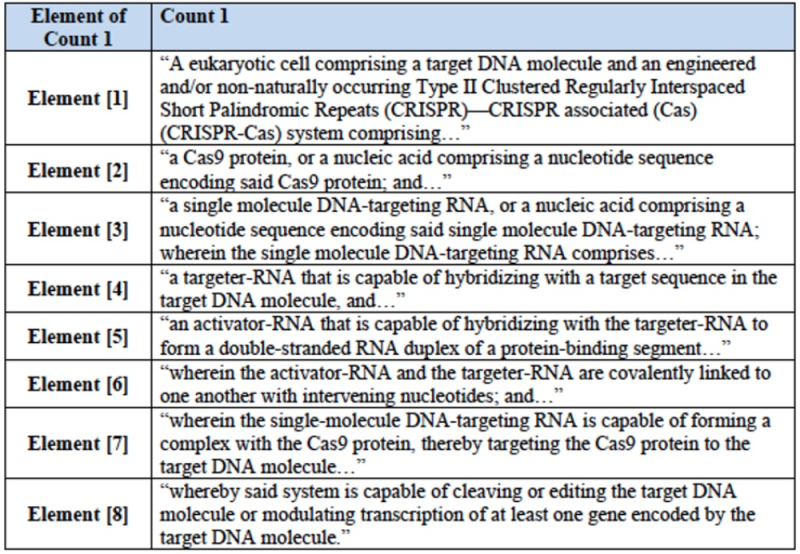On June 11th, Junior Party the University of California, Berkeley; the University of Vienna; and Emmanuelle Charpentier (collectively, "CVC") filed its Responsive Preliminary Motion No. 2 in Interference No. 106,127 to be accorded benefit of priority to U.S. provisional application No. 13/842,859, filed March 15, 2013, pursuant to 37 C.F.R. §§ 41.121(a)(2) and 41.208(a)(3) and Standing Order ¶ 208.4.1. CVC filed this motion contingent on the Board granting Senior Party ToolGen's Substantive Preliminary Motion No. 2 to deny CVC priority benefit to U.S. provisional application No. 16/757,640, filed January 28, 2013 ("P3").
ToolGen's Substantive Preliminary Motion No. 2 challenged CVC's entitlement to priority benefit to the P3 provisional in this interference on the grounds that it did not disclose "successful cleavage of DNA within eukaryotic cells, nor does it otherwise show a constructive reduction to practice of an embodiment within Count 1." Deferring its arguments against this motion to its Opposition, in this Responsive Motion CVC seeks to establish its entitlement to later-filed applications, to retain its best priority position against ToolGen (CVC itself has filed its Preliminary Motion No. 2 to deny ToolGen of the priority benefit to its earliest application, U.S. provisional application No. 16/717,324, filed October 23, 2012). In its Responsive Motion, CVC argues entitlement to the '859 application as a matter of law because it is the earliest application having an identical specification to CVC's applications-in-interference and CVC argues that it therefore is entitled to a presumption that this application provides a constructive reduction to practice thereby, citing Transco Prod. Inc. v. Performance Contracting, Inc., 38 F.3d 551, 556–57 (Fed. Cir. 1994). In the alternative, CVC in this motion asks to be accorded benefit of the filing date of U.S. Application No. 14/685,504, filed April 13, 2015 ("the '504 application") or U.S. Application No. 15/138,604, filed April 26, 2016 ("the '604 application"), all of which share a common specification with the '859 application "as a string of continuation applications and thus provide the same disclosure as the involved applications."
In addition to asserting the presumption that it is entitled to priority benefit to its earliest application having a specification identical to its involved applications, CVC sets forth its comparison evidence of what is disclosed in the specification of the '859 application with each element of the Count:

while at the same time reiterating its contention that it is entitled to priority benefit to its P1 (No. 61/652,086, filed May 25, 2012), P2 (No. 61/716,256, filed Oct. 19, 2012), and P3 provisional applications for providing a constructive reduction to practice of at least one embodiment falling within the scope of the Count. This assertion is based on CVC's purported demonstration of eukaryotic CRISPR-Cas9 mediated genetic alterations in its E1 (fish cell), E2 (human cell), and E3 (fruit fly cell) embodiments (see "Berkeley Files Responsive Motion to Broad's Substantive Motion No. 2 in Interference"). CVC also relies on the Board's determination in the '115 Interference that CVC was entitled to priority benefit of the P3 provisional application (see "PTAB Decides Parties' Motions in CRISPR Interference"). CVC sets forth its evidence that the relevant disclosure in the P3 provisional, as well as in the '859 application in this interference, is the same, specifically with regard to the fish, human, and fruit fly cell embodiments.
The brief sets forth separately its arguments regarding the disclosure in Example 4 of the "common specification," which the brief describes as "an RNA-guided DNA endonuclease from a Type II CRISPR system" called CRISPR interference (CRISPRi)." This system can suppress RNA transcription in human HEK293 cells, according to the brief, and that it meets all the elements of the Count in the '127 interference. This example also avoids the criticism ToolGen aimed at CVC's Example 3 with regard to cell lysis being used to isolate CRISRP-modified DNA (which ToolGen asserts could result in artifactual, in vitro CRISPR cleavage outside the scope of the Count). CVC argues in its brief that CRISPRi down-regulates transcription inside the cell without the need for cell lysis and thus ToolGen's criticism on this basis is inapposite.
The "common specification" also contains Example 5 according to the brief, which CVC argues discloses use of a "a fusion protein compr[i]sing a catalytically inactive Cas9 and an . . . activator domain or a repressor domain" that also modulates transcription within a eukaryotic cell. According to CVC the CRISPR system disclosed in Example 5 also comprises all the elements recited in the interference Count.
Finally CVC relies on disclosure in the common specification of Example 7, which discloses generating:
"[a] transgenic mouse expressing Cas9," isolating embryonic stem cells from the transgenic mouse, and using the Cas9-expressing embryonic stem cells to rapidly generate "new knock-out or knock-in cells (and therefore mice) . . . at any desired locus in the genome by introducing an appropriately designed DNA-targeting RNA that targets the Cas9 to a particular locus of choice."
As explained by CVC's expert cited in the brief, "gene knock-in" was known in the art, produced by other means, and the CRISPR system disclosed in Example 7 satisfied all the elements recited in the Count of the 106,127 Interference.
On these grounds CVC asked the Board to be accorded benefit of the '859 application's March 15, 2013 filing date in this interference.